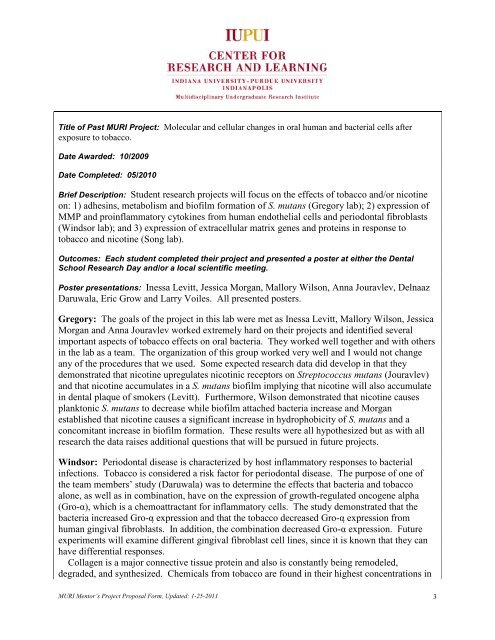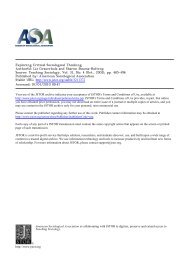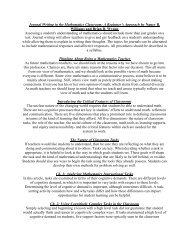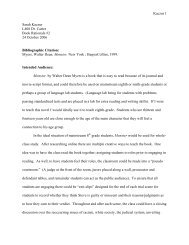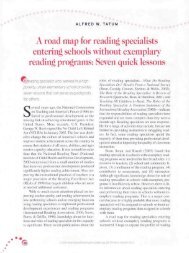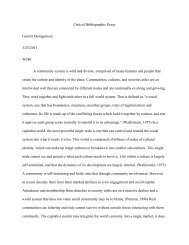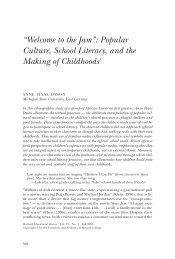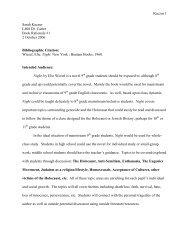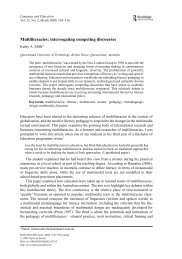Proposal - Oncourse - Indiana University
Proposal - Oncourse - Indiana University
Proposal - Oncourse - Indiana University
Create successful ePaper yourself
Turn your PDF publications into a flip-book with our unique Google optimized e-Paper software.
Title of Past MURI Project: Molecular and cellular changes in oral human and bacterial cells after<br />
exposure to tobacco.<br />
Date Awarded: 10/2009<br />
Date Completed: 05/2010<br />
Brief Description: Student research projects will focus on the effects of tobacco and/or nicotine<br />
on: 1) adhesins, metabolism and biofilm formation of S. mutans (Gregory lab); 2) expression of<br />
MMP and proinflammatory cytokines from human endothelial cells and periodontal fibroblasts<br />
(Windsor lab); and 3) expression of extracellular matrix genes and proteins in response to<br />
tobacco and nicotine (Song lab).<br />
Outcomes: Each student completed their project and presented a poster at either the Dental<br />
School Research Day and/or a local scientific meeting.<br />
Poster presentations: Inessa Levitt, Jessica Morgan, Mallory Wilson, Anna Jouravlev, Delnaaz<br />
Daruwala, Eric Grow and Larry Voiles. All presented posters.<br />
Gregory: The goals of the project in this lab were met as Inessa Levitt, Mallory Wilson, Jessica<br />
Morgan and Anna Jouravlev worked extremely hard on their projects and identified several<br />
important aspects of tobacco effects on oral bacteria. They worked well together and with others<br />
in the lab as a team. The organization of this group worked very well and I would not change<br />
any of the procedures that we used. Some expected research data did develop in that they<br />
demonstrated that nicotine upregulates nicotinic receptors on Streptococcus mutans (Jouravlev)<br />
and that nicotine accumulates in a S. mutans biofilm implying that nicotine will also accumulate<br />
in dental plaque of smokers (Levitt). Furthermore, Wilson demonstrated that nicotine causes<br />
planktonic S. mutans to decrease while biofilm attached bacteria increase and Morgan<br />
established that nicotine causes a significant increase in hydrophobicity of S. mutans and a<br />
concomitant increase in biofilm formation. These results were all hypothesized but as with all<br />
research the data raises additional questions that will be pursued in future projects.<br />
Windsor: Periodontal disease is characterized by host inflammatory responses to bacterial<br />
infections. Tobacco is considered a risk factor for periodontal disease. The purpose of one of<br />
the team members’ study (Daruwala) was to determine the effects that bacteria and tobacco<br />
alone, as well as in combination, have on the expression of growth-regulated oncogene alpha<br />
(Gro-α), which is a chemoattractant for inflammatory cells. The study demonstrated that the<br />
bacteria increased Gro-α expression and that the tobacco decreased Gro-α expression from<br />
human gingival fibroblasts. In addition, the combination decreased Gro-α expression. Future<br />
experiments will examine different gingival fibroblast cell lines, since it is known that they can<br />
have differential responses.<br />
Collagen is a major connective tissue protein and also is constantly being remodeled,<br />
degraded, and synthesized. Chemicals from tobacco are found in their highest concentrations in<br />
MURI Mentor’s Project <strong>Proposal</strong> Form, Updated: 1-25-2011 3


